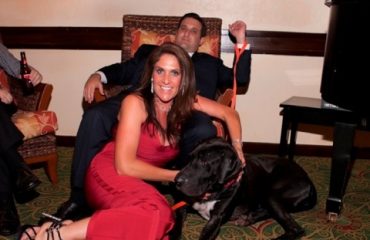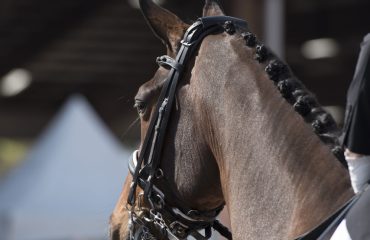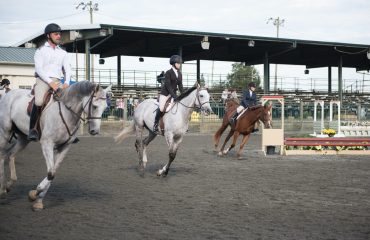By Jan Westmark-Allan
Many horse owners, at one time or another, experience lameness issues with their horses. The heartache for the owner can be devastating, especially if a horse is at the peak of their career. Atlanta-based Suzanne Dansby-Bollman knows all too well the feeling of heartache, and the long and often frustrating journey to recovery. She also knows a thing or two about miracles.
Suzanne and Cooper, her 18.3 hand Holsteiner gelding, were on top of the world four years ago when Cooper won the Grand Prix Freestyle at the Wellington CDI. In March of 2007, however, Cooper came up lame with a suspensory injury that required stem cell replacement therapy. “All along, from the time he was injured, I felt as if we had unfinished business left to take care of. Cooper was in his prime, and we were in the prime of our career together. It came to such an abrupt end,” Suzanne said.
Against all odds, the giant of a horse has made an amazing comeback. Now 19, Cooper has not only returned to the ring but is back where he left off, competing on the Grand Prix circuit. While Suzanne admits the journey has been an exhausting one, she is elated that she has been given another chance with Cooper “This time I feel differently and am trying not to pressure myself with any expectations, but just enjoy the ride. Before his injury, I was uptight and worried about whether I would qualify for this or that. Now I just want to enjoy my horse friends I missed all of these years, the shows and my horse. Every opportunity with Cooper is a gift. We have had a lot of success over the years, but Cooper’s biggest success to date is his return to soundness after so many years, and as a 19-year-old!”
Sidelines: What took Cooper out of competition?
SDB: Cooper came up lame in his left hind in late March of 2007. We found it was his suspensory, which required rest and finally stem cell replacement therapy. The surgery took place under the careful and steady hand of Dr. Bob Brusie at Palm Beach Equine Clinic. He had to extract the stem cells from Cooper’s sternum, so Cooper had to be knocked out and on the table. He came out with flying colors and although he recovered well, it took a long time and a great deal of patience for him to recuperate.
Sidelines: How did you handle Cooper’s road to recovery?
SDB: Over the past four years Cooper suffered numerous setbacks. I was just about ready to give up when my vet, Dr. Bob Grisel, insisted on giving Cooper another chance. Last April, Dr. Grisel gave me a prescription for a 60-day plan for returning back to work. After a couple of months, I was riding him in serpentines and big 20-meter circles and then began doing some easy transitions that turned into bigger transitions. By September, we were ready to do some third-level movements and transitions, which developed as time went on. We did our first Grand Prix level work in November during a clinic with Conrad Schumacher. Mr. Schumacher gave me his approval and encouraged me to show Cooper if I wanted to, so off to Florida we went. Our first return to the ring was in February, and we earned a whopping score of 69+%. What a comeback! We now joke that his nickname should be “Comeback Coop!”
Sidelines: What is so special about Cooper?
SDB: Cooper draws a crowd everywhere he goes, not only because of his presence but also because of his personality. He is a “gentle giant” in the stable, and sensitive and hot in the arena. Whenever people come up to him and begin asking questions in awe of his size, he just stands there and takes it all in. Sometimes people will even begin asking me about Cooper when I stop to put on my jacket and am trying to concentrate on going into the arena for a test. Like Mickey Mouse, people love to pose with Cooper to have their picture taken. He has had his picture taken with little babies, children, grandmas and many people I don’t even know.
Sidelines: What are some great memories you have of competing Cooper?
SDB: Before his sabbatical in 2007, we were winning every show we entered. We had qualified for the World Cup Selection Trials when we won the USEF World Cup qualifying Grand Prix freestyle classes at the 2007 Heidelburg Cup and at the Wellington CDI, but I opted not to take him. I felt like it was just too much, since he would have to travel to California only a week later. I also have great memories of our musical freestyles. Our last one was at the Washington International Dressage Invitational in the fall of 2006 and we had a blast in front of the crowd of 15,000 people. The spectators were in awe of Cooper’s expressive pirouettes, passage and tempi changes. We did our last piaffe to a piaffe pirouette, to a one-handed passage to our final halt to a standing ovation. The crowd went nuts.
Sidelines: What advice do you have for other horse owners who are rehabilitating a horse?
SDB: My best advice to people bringing their horse back from time off is to have patience and not allow your own ambitions and desires to take over. Also, I recommend hiring the best health care professionals you can find, starting with your vets, farrier and groom. It is also important to learn as much as you can about treatment for your particular issue, from several vets and other horse people. Be methodical with your training and care program. Most importantly, don’t lose hope. There may be a miracle around the corner!














